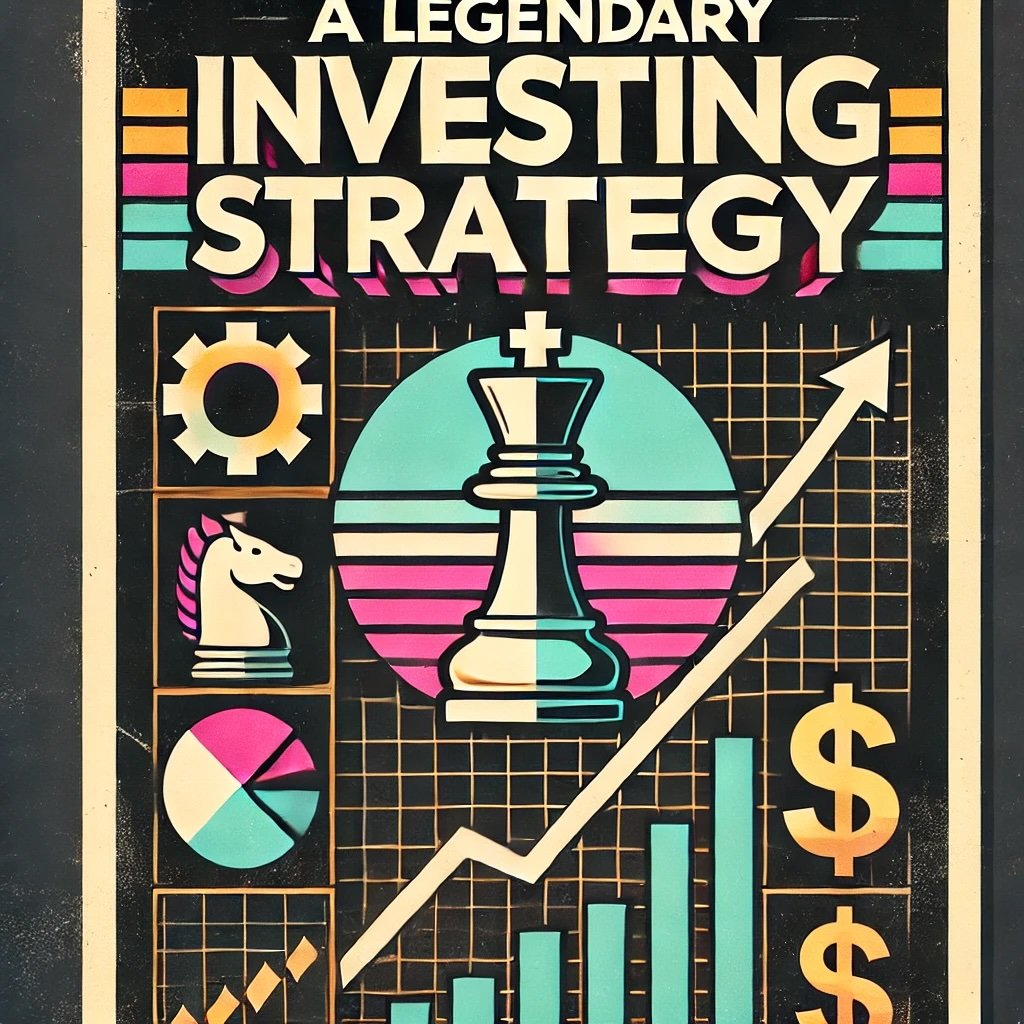Investing can often feel like deciphering a complex code, especially with the plethora of options, strategies, and financial jargon that saturate the market. Amidst this complexity, one visionary revolutionized the investment landscape by simplifying it for the everyday investor—Jack Bogle, the founder of Vanguard Group. Bogle’s groundbreaking approach centered on low-cost investing, the power of index funds, and a steadfast commitment to long-term growth. His principles not only democratized investing but also challenged the traditional norms of Wall Street.
source: Value Investing Guru on YouTube
Jack Bogle believed that investing should be accessible and fair, allowing individuals from all walks of life to build wealth over time. He introduced the first index mutual fund available to retail investors, a move that was initially met with skepticism but later hailed as one of the most significant innovations in the financial industry. His emphasis on minimizing costs and avoiding unnecessary complexity has helped millions of people achieve their financial goals.
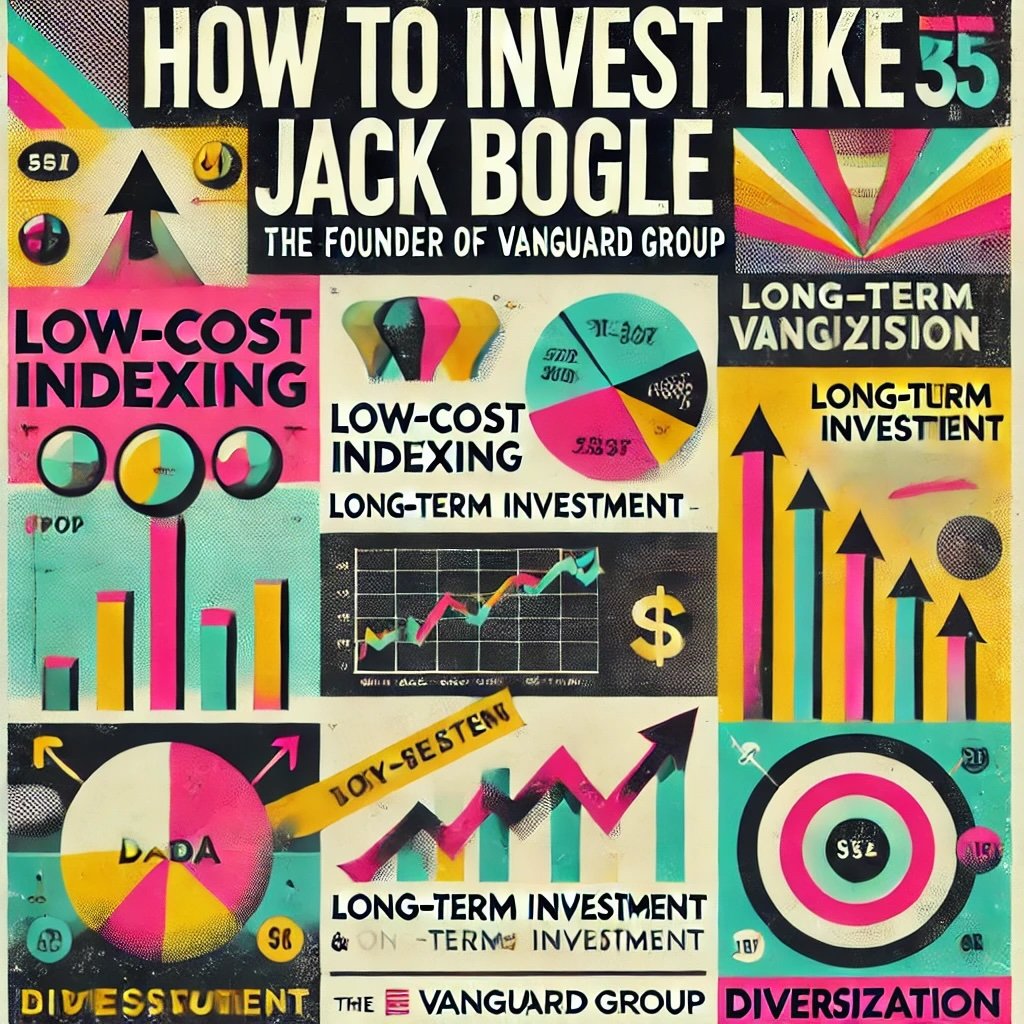
This comprehensive guide delves into Jack Bogle’s investment philosophy and provides practical steps on how you can apply his wisdom to your own financial journey. Whether you’re a novice investor or have years of experience, understanding and implementing Bogle’s principles can lead to a more robust and diversified portfolio that aligns with your long-term objectives.
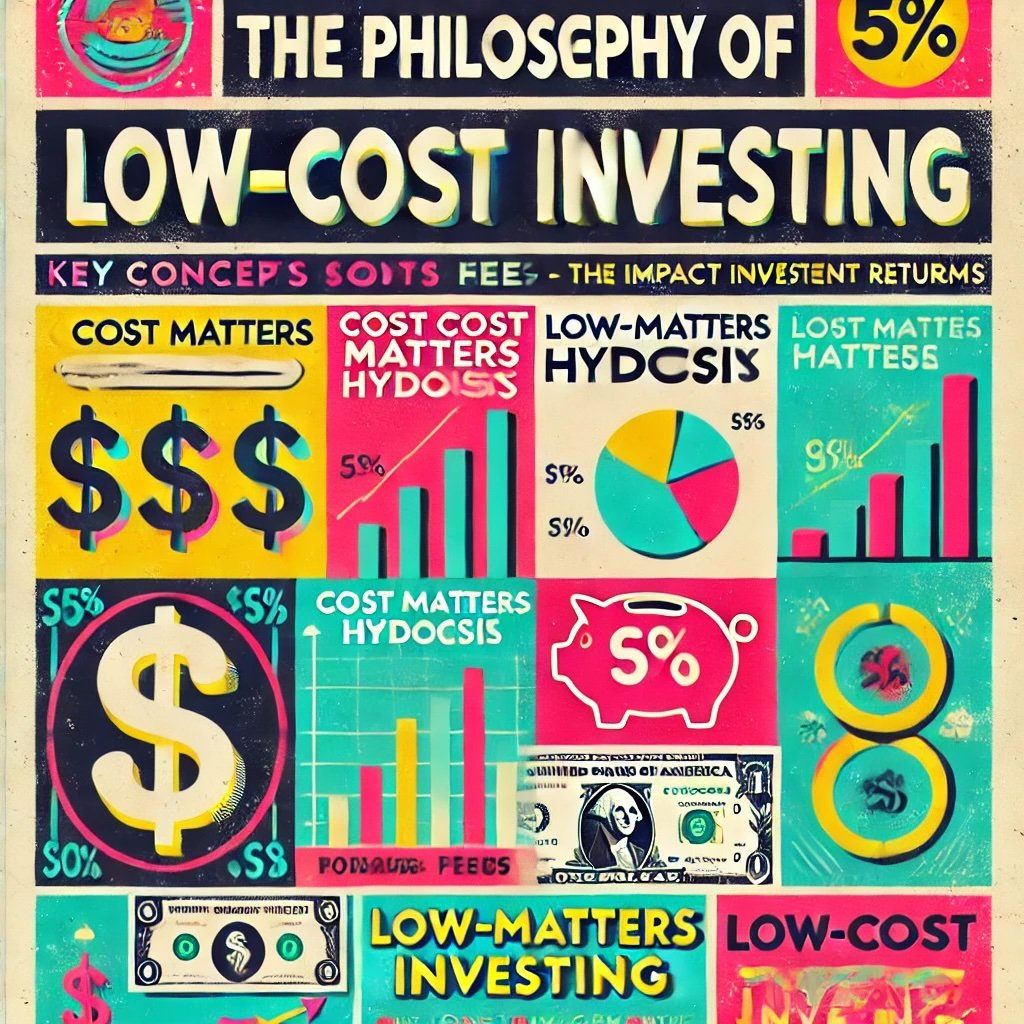
The Philosophy of Low-Cost Investing
Cost Matters Hypothesis
At the core of Jack Bogle’s investment philosophy lies a simple yet profound concept: cost matters. Bogle introduced the “Cost Matters Hypothesis,” which asserts that the expenses associated with investing—such as management fees, transaction costs, and taxes—significantly erode investment returns over time. Unlike the Efficient Market Hypothesis, which suggests that all known information is already reflected in stock prices, Bogle’s hypothesis emphasizes the tangible impact of costs on an investor’s bottom line.
Consider this: If you earn an average annual return of 7% on your investments but pay 2% in fees and expenses, your net return drops to 5%. Over the course of several decades, this seemingly small difference can lead to a substantial reduction in your accumulated wealth. Bogle’s insight was that by minimizing these costs, investors could retain more of their returns, allowing the magic of compounding to work more effectively in their favor.
Expense Ratios Explained
The expense ratio is a critical metric when evaluating investment funds. It represents the annual fee that funds charge their shareholders, expressed as a percentage of the assets under management. This fee covers a range of expenses, including administrative costs, management fees, and operational expenses. For example, if you invest $10,000 in a fund with an expense ratio of 1%, you’ll pay $100 in fees that year.
High expense ratios can significantly impact your investment returns over time. A fund with an expense ratio of 1.5% may not seem much more expensive than one with a 0.5% ratio, but over 30 years, the difference becomes substantial due to the effects of compounding. Bogle championed low-cost funds because they allow investors to keep more of their money invested, thereby enhancing the potential for long-term growth.
Practical Application: Choosing Low-Cost Investments
To apply Bogle’s low-cost investing philosophy effectively, consider the following steps:
- Research and Compare Expense Ratios: When evaluating mutual funds or ETFs, look for those with the lowest expense ratios. Many financial websites and fund prospectuses provide this information readily.
- Opt for Passive Over Active Management: Actively managed funds typically have higher fees due to the costs associated with frequent trading and research. Passive funds, such as index funds, aim to replicate the performance of a market index and generally have much lower expense ratios.
- Beware of Hidden Fees: Some funds may have additional costs like sales loads, redemption fees, or 12b-1 fees. Always read the fine print to understand the total cost of ownership.
- Utilize Low-Cost Brokerage Platforms: Many online brokers offer commission-free trades and no account maintenance fees. This can further reduce your overall investment costs.
- Consider Tax Efficiency: Taxes can also eat into your returns. Index funds tend to be more tax-efficient than actively managed funds due to lower turnover rates.
By consciously selecting low-cost investment options and being mindful of all associated fees, you’re aligning your portfolio with Bogle’s philosophy and increasing your potential for long-term success.

The Power of Index Fund Investing
What is an Index Fund?
An index fund is a type of mutual fund or ETF designed to replicate the performance of a specific market index, such as the S&P 500, NASDAQ Composite, or Russell 2000. Instead of trying to outperform the market through active management and stock selection, index funds aim to match the market’s performance by holding all, or a representative sample, of the securities in the index they track.
Jack Bogle’s creation of the first index mutual fund available to retail investors—the Vanguard 500 Index Fund—in 1976 was a groundbreaking moment in the investment world. His vision was to provide a simple, low-cost investment vehicle that would allow everyday investors to achieve market returns without the high fees and risks associated with active management.
Benefits of Index Funds
Index funds offer several compelling advantages:
- Diversification: By investing in an index fund, you’re automatically diversified across all the companies in that index. This spreads your risk across various sectors and industries.
- Low Costs: Index funds have lower operating expenses because they require less research and trading activity. This means more of your money stays invested and working for you.
- Simplicity: Index investing is straightforward. You don’t need to analyze individual stocks or time the market. Your investment mirrors the performance of the market index.
- Consistent Performance: While index funds aim to match market performance, studies have shown that they often outperform the majority of actively managed funds over the long term due to lower fees and the difficulty active managers have in consistently beating the market.
How Bogle’s Index Fund Revolutionized Investing
When Jack Bogle introduced the Vanguard 500 Index Fund, he faced significant skepticism. Critics dubbed it “Bogle’s Folly,” doubting that investors would settle for average market returns rather than pursuing higher gains through active management. However, Bogle’s vision proved prescient.
The success of the Vanguard 500 Index Fund demonstrated that investors valued low costs and reliable returns over the unpredictability and higher expenses of actively managed funds. This shift led to the proliferation of index funds and ETFs, making diversified, low-cost investing accessible to millions of people worldwide.
Today, index funds are a cornerstone of many investment portfolios, embodying Bogle’s principles of simplicity, cost efficiency, and long-term focus.

The Importance of Diversification
Diversification Explained
Diversification is a risk management strategy that involves spreading your investments across various asset classes, sectors, and geographic regions to reduce exposure to any single asset or risk. The idea is that different assets often perform differently under the same market conditions. By holding a mix of investments, you can mitigate the impact of poor performance in any one area.
For example, if you invest solely in technology stocks and the tech sector experiences a downturn, your portfolio could suffer significant losses. However, if your investments are diversified across sectors like healthcare, consumer goods, and energy, a downturn in one sector may be offset by stability or gains in others.
Bogle’s Approach to Diversification
Jack Bogle advocated for broad diversification through the use of total market index funds. He believed that by owning a piece of the entire market, investors could reduce the unsystematic risk associated with individual securities or sectors.
Bogle’s approach emphasized:
- Market-Wide Exposure: Investing in funds that cover the entire market, such as total stock market index funds, to capture the performance of all sectors and industries.
- Avoiding Overconcentration: Steering clear of heavy allocations to specific sectors or companies that could increase risk.
- International Diversification: While Bogle was somewhat cautious about international investments due to additional costs and currency risks, he acknowledged the potential benefits of including international exposure for diversification.
Implementing Diversification with Index Funds and ETFs
To build a diversified portfolio using Bogle’s principles:
- Invest in Broad Market Index Funds: Start with a total U.S. stock market index fund, which provides exposure to large, mid, and small-cap companies across various industries.
- Include International Index Funds: Consider adding a total international stock index fund to gain exposure to developed and emerging markets outside the U.S.
- Incorporate Bond Index Funds: Add a total bond market index fund to balance the volatility of equities and provide a steady income stream.
- Balance Asset Classes: Adjust the proportion of stocks and bonds based on your risk tolerance and investment horizon.
- Rebalance Periodically: Over time, market movements can shift your portfolio’s asset allocation. Rebalancing ensures that you maintain your desired level of diversification and risk.
By using index funds and ETFs that track broad market indexes, you can achieve diversification efficiently and cost-effectively, adhering to Bogle’s emphasis on simplicity and low costs.
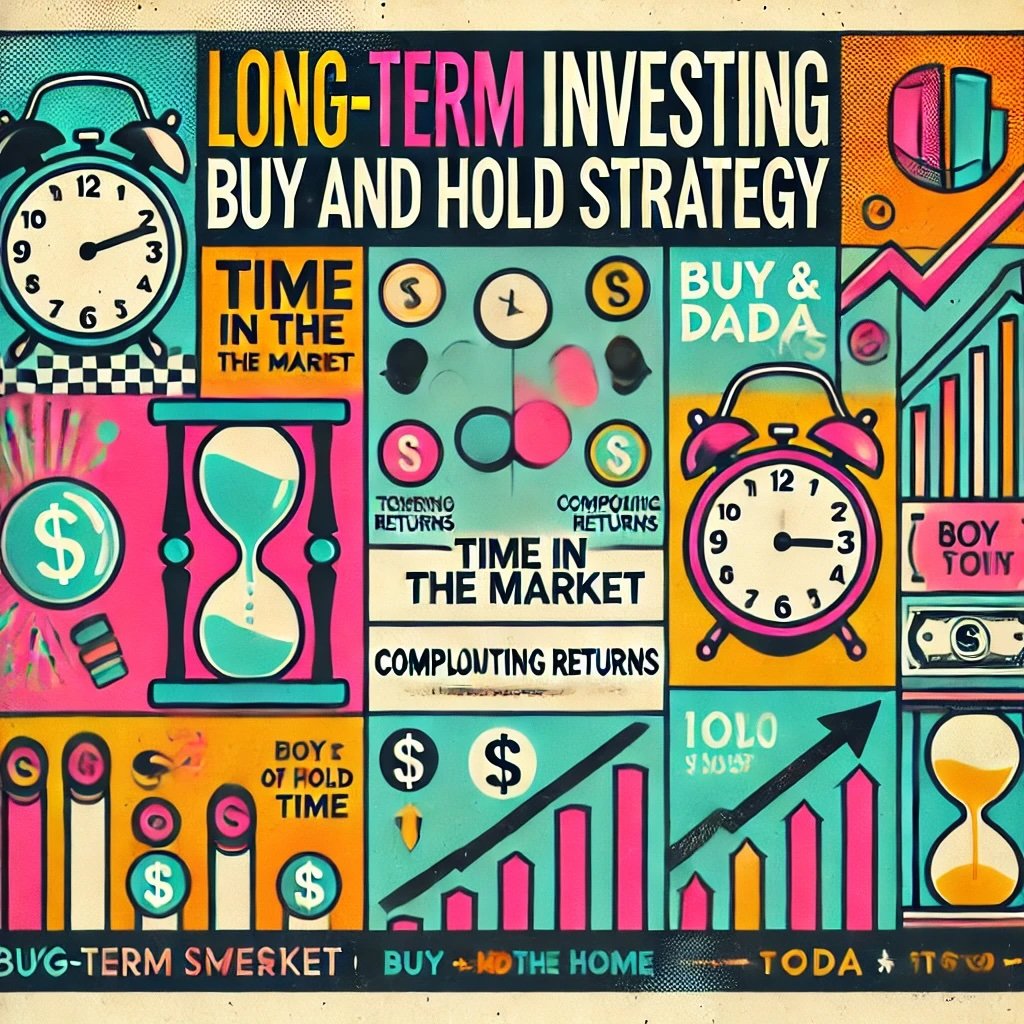
Long-Term Investing
Buy and Hold Strategy
The buy and hold strategy involves purchasing securities and holding them for an extended period, often years or decades, regardless of short-term market fluctuations. This approach capitalizes on the historical tendency of markets to rise over the long term and leverages the power of compounding returns.
Jack Bogle was a staunch advocate of the buy and hold strategy. He believed that time in the market was more critical than timing the market. By staying invested, you benefit from the growth of the economy and corporate profits, as reflected in rising stock prices and dividends over time.
Avoiding Market Timing
Market timing—the attempt to predict future market movements to buy low and sell high—is a practice Bogle strongly discouraged. He argued that:
- Predicting Market Movements is Nearly Impossible: Even professional investors struggle to time the market successfully.
- Emotional Investing Leads to Mistakes: Decisions driven by fear or greed often result in buying high and selling low.
- Transaction Costs and Taxes: Frequent trading increases costs and can trigger capital gains taxes, reducing net returns.
- Opportunity Cost: Staying out of the market during periods of growth can significantly impact long-term returns.
By avoiding market timing and focusing on long-term investing, you reduce the risk of making costly mistakes and allow your investments to grow unhindered over time.
Case Study: Historical Performance of Index Funds
Historical data underscores the effectiveness of Bogle’s long-term investment approach. Let’s consider the performance of the S&P 500 index:
- Consistent Growth Over Time: Despite short-term volatility, the S&P 500 has delivered an average annual return of approximately 10% since its inception, including dividends.
- Recovery from Downturns: The market has recovered from every downturn, including significant events like the 2008 financial crisis and the dot-com bubble burst.
- Impact of Staying Invested: Investors who remained invested during market downturns and continued to contribute to their portfolios often saw substantial gains when the market rebounded.
For example, an initial investment of $10,000 in an S&P 500 index fund in 1980 would have grown to over $700,000 by 2020, assuming dividends were reinvested and no withdrawals were made. This illustrates the power of long-term, disciplined investing and the benefits of the buy and hold strategy.
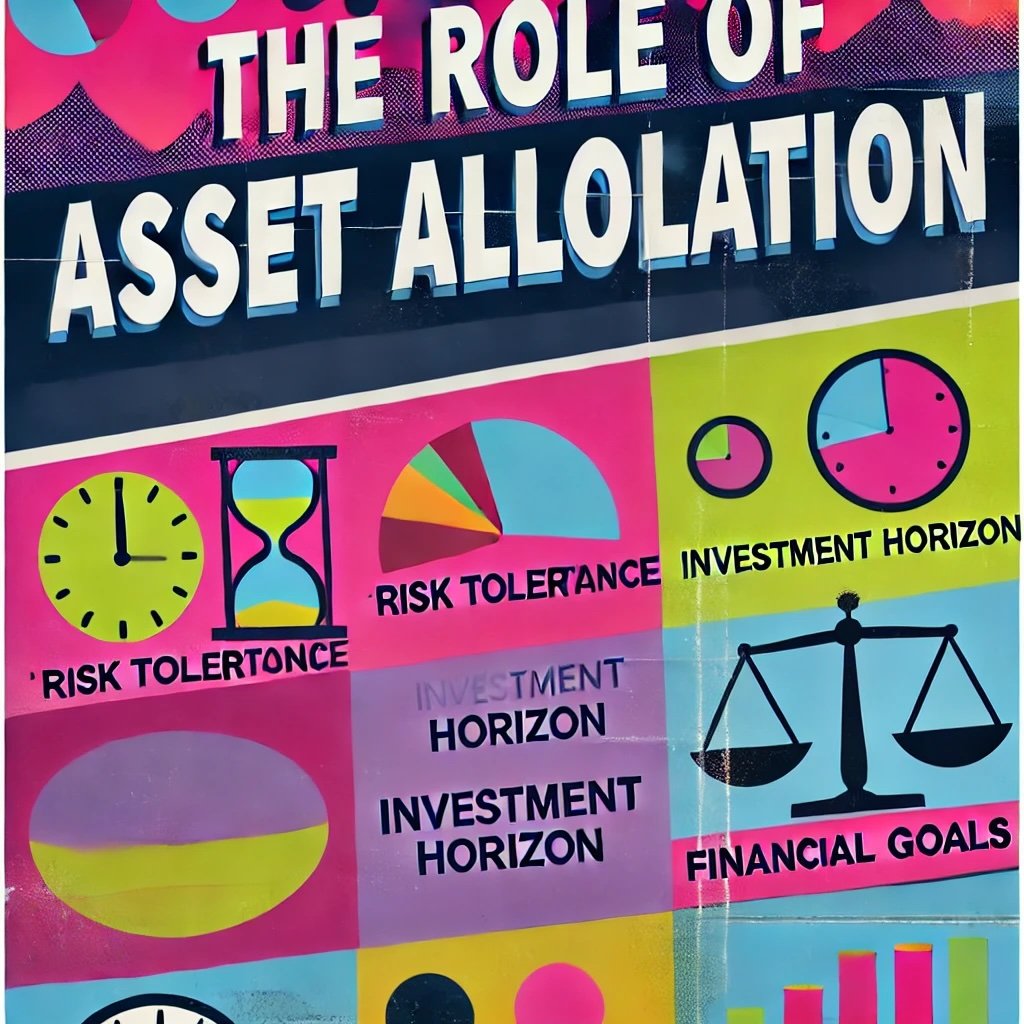
The Role of Asset Allocation
Asset Allocation Basics
Asset allocation involves dividing your investment portfolio among different asset categories—such as stocks, bonds, and cash equivalents—to optimize risk and return based on your investment goals, time horizon, and risk tolerance.
Key considerations in asset allocation include:
- Risk Tolerance: Your comfort level with the possibility of losing money in the short term for the potential of higher returns in the long term.
- Investment Horizon: The amount of time you expect to hold your investments before needing the money.
- Financial Goals: Objectives like retirement, buying a home, or funding education, which influence your investment strategy.
Bogle’s Advice on Asset Allocation
Jack Bogle offered practical guidelines for asset allocation:
- Age-Based Allocation: A common rule of thumb he suggested is to hold a percentage of bonds roughly equal to your age. For instance, a 30-year-old might have 30% in bonds and 70% in stocks, while a 60-year-old might have a 60/40 split.
- Adjust for Risk Tolerance: Modify the allocation based on your individual risk tolerance. If you’re more conservative, you might increase your bond holdings; if you’re more aggressive, you might have a higher proportion of stocks.
- Simplify with Balanced Funds: Bogle recommended using balanced index funds or target-date funds that automatically adjust the asset allocation over time, simplifying the investment process.
- Stay the Course: Resist the urge to alter your asset allocation in response to market conditions. Stick to your long-term plan unless your personal circumstances change.
Example: A Bogle-Inspired Model Portfolio
Here’s an example of a simple, diversified portfolio based on Bogle’s principles:
- 60% Vanguard Total Stock Market Index Fund (VTSAX): Provides comprehensive exposure to the entire U.S. equity market.
- 20% Vanguard Total International Stock Index Fund (VTIAX): Adds diversification through international developed and emerging markets.
- 20% Vanguard Total Bond Market Index Fund (VBTLX): Offers stability and income through a broad range of U.S. investment-grade bonds.
This portfolio is easy to manage, cost-effective, and diversified across asset classes and geographies. Investors can adjust the percentages based on their age and risk tolerance, maintaining alignment with their long-term investment objectives.

Emphasis on Simplicity
Keep It Simple
One of Bogle’s enduring legacies is his advocacy for simplicity in investing. He believed that complex investment strategies and products often lead to higher costs and increased risks without delivering better returns. Simplicity, he argued, enhances transparency, reduces errors, and increases the likelihood of achieving investment goals.
Avoiding Complexity and Frequent Trading
Bogle warned against:
- Complex Financial Products: Such as hedge funds, derivatives, or structured notes, which can be opaque and carry hidden risks and fees.
- Market Fads and Trends: Chasing the latest investment craze often leads to poor outcomes and detracts from long-term goals.
- Frequent Trading: High turnover increases transaction costs and taxes, undermining returns.
- Information Overload: Excessive attention to market news and short-term fluctuations can lead to emotional decision-making.
By keeping your investment strategy simple, you minimize unnecessary costs and focus on what truly matters: consistent contributions, appropriate asset allocation, and long-term growth.
Practical Tips for Simplifying Your Investment Approach
To simplify your investing:
- Use a Limited Number of Funds: A portfolio of just a few index funds can provide broad diversification without complexity.
- Automate Your Investments: Set up automatic contributions to your investment accounts to ensure regular investing without the need for constant decision-making.
- Set It and Forget It: Once you’ve established your investment plan, avoid the temptation to make frequent changes. Review your portfolio periodically, such as annually, rather than constantly reacting to market movements.
- Educate Yourself on the Basics: Focus on fundamental investment principles rather than getting bogged down in technical analysis or speculative strategies.
- Ignore Market Noise: Concentrate on your long-term objectives rather than daily market fluctuations or sensational headlines.
By adhering to these practices, you enhance the efficiency and effectiveness of your investment strategy, aligning with Bogle’s emphasis on simplicity.

The Boglehead Community
Who are the Bogleheads?
The Bogleheads are a community of investors dedicated to following Jack Bogle’s investment philosophies. Originating from an online forum, the Bogleheads community has grown into a global network of individuals who share knowledge, resources, and support for like-minded investors.
Key Principles of the Boglehead Philosophy
The Boglehead philosophy is built on several core principles:
- Live Below Your Means: Practice frugality to save more for investing.
- Develop a Sound Financial Plan: Establish clear financial goals and an investment strategy to achieve them.
- Diversify Broadly: Spread investments across various asset classes to reduce risk.
- Keep Costs Low: Minimize fees and expenses to maximize returns.
- Invest for the Long Term: Focus on long-term growth rather than short-term gains.
- Maintain Discipline: Stick to your investment plan, even during market volatility.
- Simplify Your Portfolio: Use straightforward investment vehicles like index funds.
Resources and How to Join
To engage with the Boglehead community:
- Visit the Bogleheads Forum: Join discussions at Bogleheads.org, where you can ask questions, share experiences, and learn from seasoned investors.
- Access the Bogleheads Wiki: A comprehensive resource covering a wide range of financial and investing topics.
- Participate in Local Chapters: Connect with fellow Bogleheads in your area through local meetings and events.
- Read Recommended Literature: Books like The Bogleheads’ Guide to Investing and Common Sense on Mutual Funds by Jack Bogle provide valuable insights.
- Attend Conferences: The Bogleheads hold annual conferences featuring discussions, presentations, and Q&A sessions with investment experts.
By tapping into these resources, you can deepen your understanding of Bogle’s principles and become part of a supportive community committed to sound investing practices.

Ethical and Social Responsibility in Investing
Bogle’s Perspective on Ethics
Jack Bogle was not only a champion of low-cost investing but also a vocal advocate for ethical practices in the financial industry. He criticized the industry for putting its interests ahead of those of investors, often highlighting excessive fees, conflicts of interest, and lack of transparency.
Bogle believed that the primary responsibility of financial institutions was to serve their clients. He emphasized stewardship over salesmanship, arguing that trust and integrity were essential for the industry to fulfill its role in society.
Socially Responsible Investing (SRI)
Socially Responsible Investing (SRI) involves selecting investments based on ethical, social, and environmental criteria, in addition to financial considerations. While Bogle recognized the importance of aligning investments with personal values, he also cautioned investors to be mindful of the potential trade-offs.
- Higher Costs: SRI funds may have higher expense ratios due to additional research and screening processes.
- Limited Diversification: Excluding certain sectors or companies can reduce diversification, potentially increasing risk.
- Performance Variability: SRI funds may underperform or outperform the broader market depending on the excluded industries’ performance.
Implementing SRI Principles
If you’re interested in incorporating ethical considerations into your investing:
- Identify Your Values: Determine which ethical, social, or environmental issues are most important to you.
- Research SRI Funds: Look for funds that align with your values, such as those focusing on renewable energy, social justice, or companies with strong corporate governance.
- Evaluate Costs and Performance: Compare the expense ratios and historical performance of SRI funds to ensure they meet your investment criteria.
- Consider Impact Investing: Beyond SRI, impact investing involves investing in companies or projects that aim to generate measurable social or environmental impact alongside financial returns.
- Balance Values with Financial Goals: Ensure that your ethical investments support your overall financial objectives and risk tolerance.
By thoughtfully integrating SRI into your portfolio, you can invest in a way that reflects your values while adhering to sound investment principles, staying true to both ethical considerations and Bogle’s emphasis on low costs and diversification.
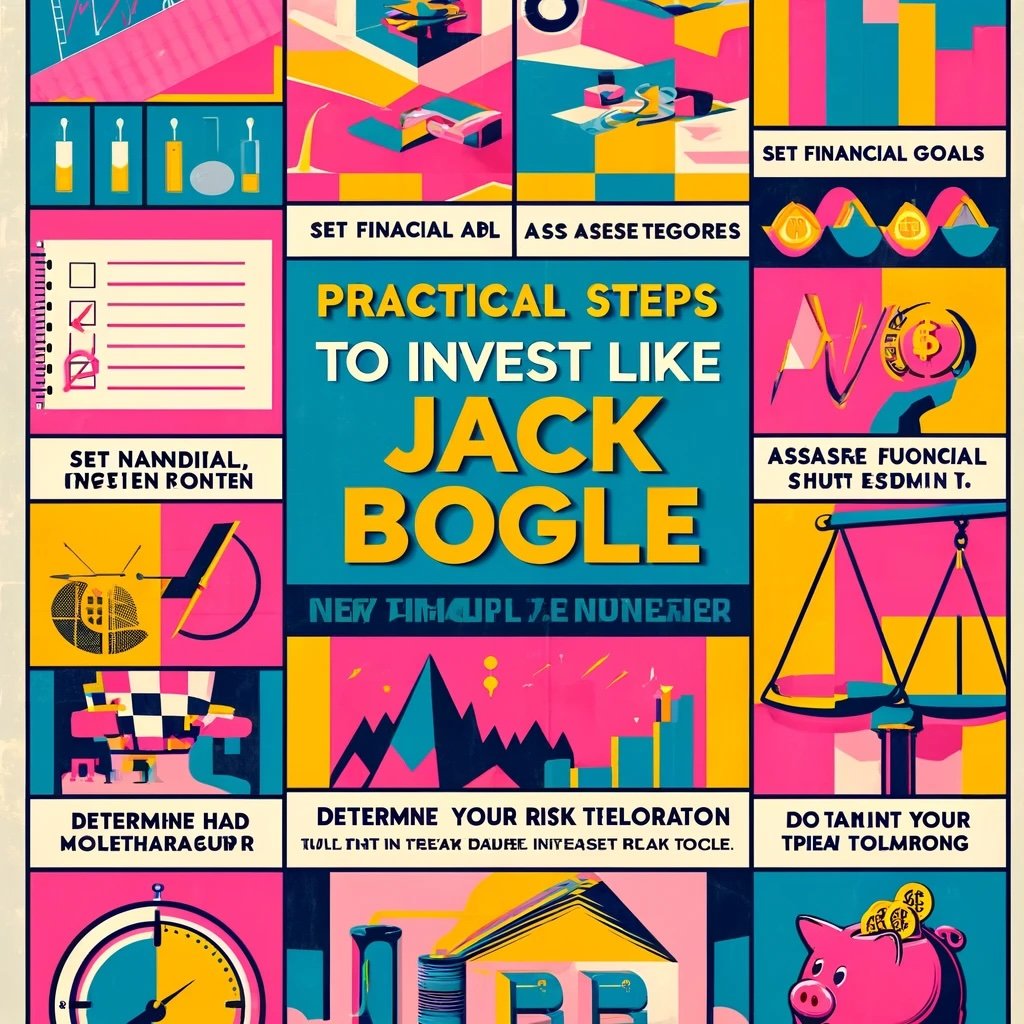
Practical Steps to Invest Like Jack Bogle
Getting Started
Embarking on your investment journey using Bogle’s principles involves several key steps:
- Set Clear Financial Goals: Define what you’re investing for—retirement, home purchase, education—and establish a timeline for achieving these goals.
- Assess Your Financial Situation: Evaluate your income, expenses, debts, and existing assets to determine how much you can invest regularly.
- Determine Your Risk Tolerance: Understand your comfort level with investment risk, which will influence your asset allocation.
- Educate Yourself: Gain a basic understanding of investment concepts, types of investment vehicles, and the principles of diversification and asset allocation.
Choosing Funds
When selecting investments for your portfolio:
- Prioritize Low-Cost Index Funds and ETFs: Focus on funds with low expense ratios that track broad market indexes.
- Diversify Across Asset Classes: Include a mix of equities (both domestic and international) and fixed-income securities.
- Avoid High-Fee and Complex Products: Steer clear of funds with high management fees, sales loads, or complicated strategies that don’t align with Bogle’s principles.
- Consider Target-Date Funds: These funds automatically adjust the asset allocation over time, becoming more conservative as the target date approaches.
Staying the Course
Maintaining discipline is crucial for long-term investment success:
- Stick to Your Plan: Once you’ve established your investment strategy, resist the urge to make impulsive changes based on market volatility.
- Regularly Invest: Make consistent contributions to your investment accounts, leveraging dollar-cost averaging to reduce the impact of market fluctuations.
- Rebalance Periodically: Review your portfolio at least annually to ensure your asset allocation remains aligned with your goals and risk tolerance.
- Ignore Market Noise: Focus on your long-term objectives rather than reacting to short-term market movements or sensational news headlines.
- Stay Informed but Not Obsessed: Keep abreast of general market trends and economic indicators without becoming fixated on daily price changes.
By following these steps, you embrace Bogle’s time-tested approach to investing, positioning yourself for long-term success while minimizing unnecessary risks and costs.
How to Invest Like Jack Bogle — Low-Cost Indexing, Sensible Asset Allocation, and “Stay the Course”: 12-Question FAQ
What is Jack Bogle’s core investing philosophy in one sentence?
Own the whole market at the lowest possible cost, set a sensible stock/bond mix, keep adding regularly, and stay the course for decades.
Why do “costs matter” so much?
Every basis point you pay in expense ratios, trading, loads, advisory fees, and taxes is a direct drag on returns—small annual costs compound into huge differences over a lifetime.
What did Bogle mean by “don’t look for the needle, buy the haystack”?
Rather than trying to pick winners, buy the entire market via broad index funds; this captures the average return of businesses at minimal cost and with far less effort.
Which simple portfolio best reflects Bogle’s approach?
A three-fund portfolio: total U.S. stock market index, total international stock market index (optional but common), and total U.S. bond market index—rebalanced periodically.
How should I choose my stock/bond allocation?
Use age, risk tolerance, and time horizon. A classic Bogleism: hold a bond percentage roughly near your age (then tailor up or down based on temperament and need for risk).
Should I include international stocks?
Bogle was cautious but many Bogleheads hold 0–40% of equities abroad using a total international index. Decide based on comfort with currency/political risk and diversification goals.
How often should I rebalance?
Once or twice a year (or by bands, e.g., when an asset drifts 5–10 percentage points from target). Keep it mechanical to avoid performance-chasing.
Is dollar-cost averaging part of the plan?
Yes—automate periodic contributions (paycheck investing). It reduces timing anxiety and keeps you investing through good and bad markets.
Are actively managed funds ever appropriate in Bogle’s framework?
Bogle’s data-driven view: after costs and taxes, few active funds outperform persistently. If you choose one, demand low fees, low turnover, and a long, verifiable record—but know the odds.
How does taxation fit into Bogle-style investing?
Prefer tax-efficient index funds/ETFs, place bonds in tax-advantaged accounts when possible, harvest losses prudently, and minimize turnover to defer capital gains.
What are the biggest behavioral mistakes Bogle warned about?
Market timing, performance chasing, abandoning the plan in bear markets, leverage, and complexity creep. Simplicity + discipline beat cleverness over time.
What’s a concrete Bogle-style starter plan?
Pick low-cost total-market index funds, set a stock/bond mix you can live with in a crash, automate monthly buys, ignore the noise, and review/rebalance annually.
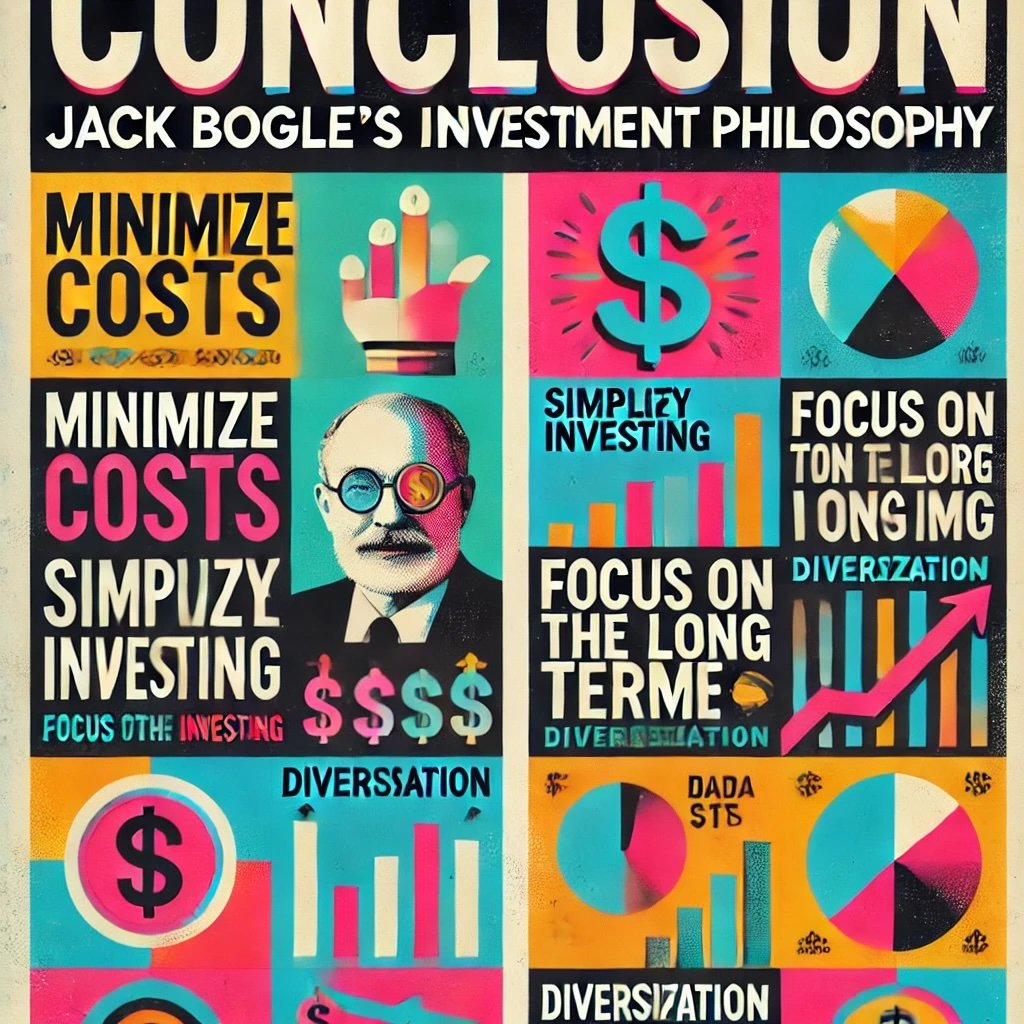
Conclusion
Jack Bogle’s investment philosophy has left an indelible mark on the financial world, empowering individual investors to take control of their financial destinies. His emphasis on low costs, broad diversification, simplicity, and long-term investing offers a clear and effective roadmap for building wealth.
In a financial landscape often characterized by complexity and high fees, Bogle’s principles provide a refreshing and accessible approach. They remind us that successful investing doesn’t require outsmarting the market or engaging in speculative strategies. Instead, it relies on discipline, patience, and adherence to sound investment practices.
By adopting Bogle’s philosophy:
- You Minimize Costs: Keeping more of your money invested and compounding over time.
- You Simplify Investing: Reducing stress and the potential for errors.
- You Focus on the Long Term: Aligning your investments with your financial goals.
- You Embrace Diversification: Managing risk effectively across different asset classes.
- You Invest Ethically: If you choose, aligning your investments with your personal values.
As you consider your own investment journey, reflect on the wisdom of Jack Bogle’s approach. Assess your current strategy, identify areas where you can reduce costs or simplify, and commit to a disciplined, long-term plan.
Start Today: The best time to invest was yesterday; the next best time is now. By taking action and staying the course, you set yourself on a path toward financial security and the achievement of your goals.
Remember, investing like Jack Bogle isn’t about chasing the next big thing; it’s about building wealth steadily and responsibly. Your future self will thank you for the decisions you make today.
Important Information
Comprehensive Investment Disclaimer:
All content provided on this website (including but not limited to portfolio ideas, fund analyses, investment strategies, commentary on market conditions, and discussions regarding leverage) is strictly for educational, informational, and illustrative purposes only. The information does not constitute financial, investment, tax, accounting, or legal advice. Opinions, strategies, and ideas presented herein represent personal perspectives, are based on independent research and publicly available information, and do not necessarily reflect the views or official positions of any third-party organizations, institutions, or affiliates.
Investing in financial markets inherently carries substantial risks, including but not limited to market volatility, economic uncertainties, geopolitical developments, and liquidity risks. You must be fully aware that there is always the potential for partial or total loss of your principal investment. Additionally, the use of leverage or leveraged financial products significantly increases risk exposure by amplifying both potential gains and potential losses, and thus is not appropriate or advisable for all investors. Using leverage may result in losing more than your initial invested capital, incurring margin calls, experiencing substantial interest costs, or suffering severe financial distress.
Past performance indicators, including historical data, backtesting results, and hypothetical scenarios, should never be viewed as guarantees or reliable predictions of future performance. Any examples provided are purely hypothetical and intended only for illustration purposes. Performance benchmarks, such as market indexes mentioned on this site, are theoretical and are not directly investable. While diligent efforts are made to provide accurate and current information, “Picture Perfect Portfolios” does not warrant, represent, or guarantee the accuracy, completeness, or timeliness of any information provided. Errors, inaccuracies, or outdated information may exist.
Users of this website are strongly encouraged to independently verify all information, conduct comprehensive research and due diligence, and engage with qualified financial, investment, tax, or legal professionals before making any investment or financial decisions. The responsibility for making informed investment decisions rests entirely with the individual. “Picture Perfect Portfolios” explicitly disclaims all liability for any direct, indirect, incidental, special, consequential, or other losses or damages incurred, financial or otherwise, arising out of reliance upon, or use of, any content or information presented on this website.
By accessing, reading, and utilizing the content on this website, you expressly acknowledge, understand, accept, and agree to abide by these terms and conditions. Please consult the full and detailed disclaimer available elsewhere on this website for further clarification and additional important disclosures. Read the complete disclaimer here.

